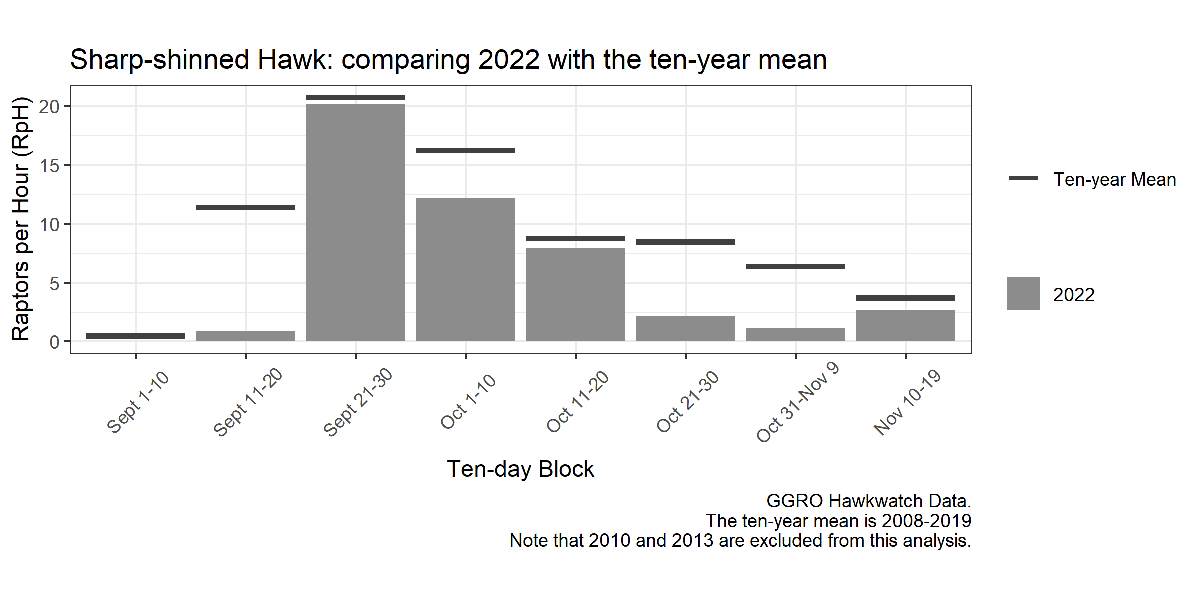Your parks need you now
Your support helps fight climate change and promote park sustainability—please give now.

An average Marin Headlands fall migration starts in mid-August. At the beginning of the season, our Hawkwatch counters are mostly seeing young Red-tailed Hawks, some Cooper’s Hawks, some Osprey, an occasional Harrier and Redshoulder, and a Peregrine cruising past Hawk Hill. By the first week in September, the Sharp-shinned Hawks start to appear in singles, then more, then around September 10th the floodgates open, and Sharpshins seem to be everywhere. Sharpshins drive the migration numbers up and up to a spike in late September and early October – a spike that often peaks around 25-30 raptors per hour (RpH).
But 2022 was different. We started counting on August 15th. On September 3rd, the first 2022 Sharpshin was counted on Hawk Hill. On September 10th, aka, Floodgate Day: no Sharpshins. Finally, on September 13th, we had two more sightings on the count. Then 25 sightings by the end of week four. Still under quota but some relief.
By the fifth week of the migration, September 26th to October 2nd, Sharpshins peaked, totaling 504 sightings for the week, or 19 RpH – about two-thirds of a normal spike, which isn’t a great concern. It was the lateness of it all. Someone forgot to turn the Sharp-shinned Hawk migration spigot on until mid-September. Cooper’s were also slow to arrive but the numbers were less dramatic.
Our Banding teams also experienced this Sharpshin delay. The first Sharp-shinned Hawk of the season wasn’t banded until September 16th and just two more on September 20th. Then the Sharpshin numbers did rise, peaking at 24 hawks banded on September 26th. The rest of the banding season was light for Sharp-shinned and Cooper’s Hawks, but never have we seen a lapse in Sharpshins like the first half of September 2022. What caused this weird and striking delay?
Talk ran rampant through the GGRO community – we blamed all the regular culprits: big spring rains squashed the nesting season; the last half-decade of mega-fires in the Pacific states ravaged nesting habitats; migration was delayed by climate change; migratory short-stopping kept songbirds and thus Sharpshins farther north. All are worthy hypotheses, and all will take years to dissect, but the bottom line was this: This event, this in-your-face,
clearly-not-normal Sharpshin delay said something else to us. It said, this is exactly why we do this work: to detect change.
This is why we have been banding and counting Pacific Flyway hawks in the Golden Gate National Recreation Area for forty years. This is why we keep a community of more than 150 volunteer biologists focused on this annual flight, and why we will continue to do so.
Just as people keep seismographic sensors attached to the ground all over California, just as people measure river flow, air temperature, or ambient noise, we are doing the work necessary so that we can detect it when something extraordinary happens – like a delay in the Sharp-shinned Hawk migration at the Golden Gate. Capturing extraordinary events is especially critical in this time of massive anthropogenic impacts. We have so much to learn about how other species respond to human-caused changes. We have many extraordinary events yet to capture.
The 2022 GGRO was made possible by 150 volunteer banders and counters, by our hard-working field staff Laura Echávez, Krista Fanucchi, and Carmen DeLeon, by our awesome park support staff and colleagues from both the Parks Conservancy and the National Park Service, by our scientific partners for their critical and inspiring research, and by the hundreds of people who donate selflessly and annually to the Golden Gate National Parks Conservancy to keep the GGRO alive and thriving. Thanks to all of you for your dedication to the conservation of the Pacific Raptor Flyway. We raise our binoculars to you.
Allen Fish, GGRO Director
Teresa Ely, GGRO Senior Biologist and Banding Manager
Conservation and Community Science Department
Golden Gate National Parks Conservancy
Golden Gate Raptor Observatory
The 2022 season summary of the Golden Gate Raptor Observatory
Your support helps fight climate change and promote park sustainability—please give now.